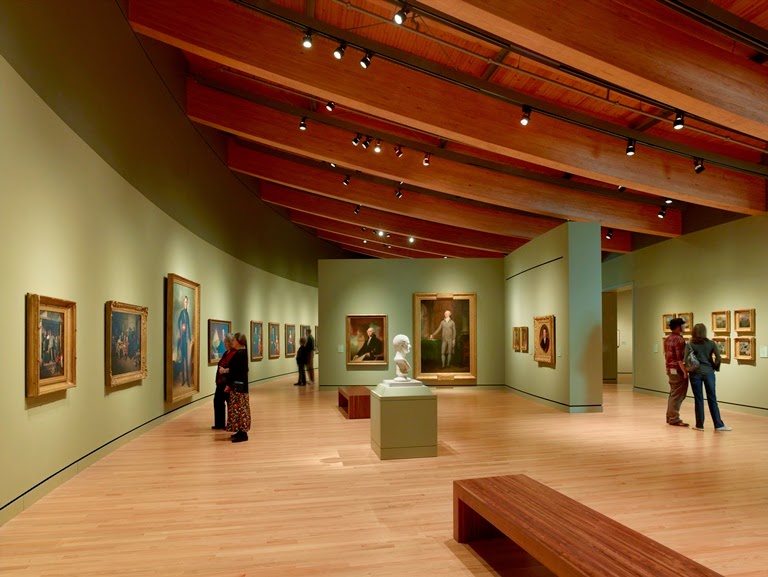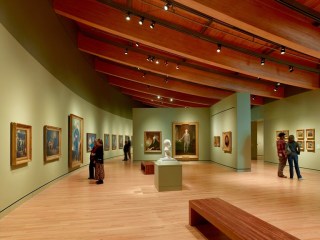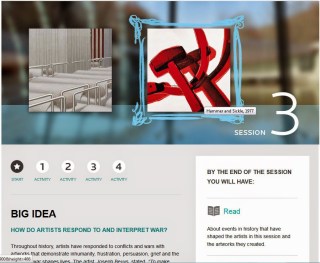
 |
| Early 19th Century Gallery at Crystal Bridges |
Last December I visited Crystal Bridges Museum of American Art in Bentonville, Arkansas, to brainstorm with their staff about museums and distance education. As Michael Edson has pointed out time and again, if museums are to scale up their impact and play a significant role in education in the U.S., they need to exploit the reach of the web. During my time there, Crystal Bridges shared a new initiative they were about to launch: an online course for high school students to take for credit towards graduation. Kirsten Peterson, project director at the educational nonprofit EDC contracted to help develop the project, gave us a brief tour of the course in its pilot form. Anne Kraybill, Crystal Bridges’ distance learning project manager, put me in touch with one of the students who tested the course prototype in 2014. Today’s guest post is by Maddy Windel, a freshman enrolled in a rural public high school, who shares her experience with this foray into online art education.
In October of 2014, I was given the opportunity to participate in the pilot of Museum Mash-Up, an online course being developed by Crystal Bridges. My English teacher/mother, Kenya Windel, heard about this opportunity through the ARTeacher Fellowship, an initiative that both she and my father have been a part of over the last few years.
Ms. Windel volunteered me for the pilot because she knows I love learning about art in general: What drives the artist? Why did they create this piece specifically? Was it inspired by a big event in the artist’s life? I also love making art. Museum Mash-Up combined all of these interests. I had never taken an online course, but I really wanted to know what one was like (in Arkansas, an online course credit is necessary for all graduates, and I wanted to feel more prepared). I didn’t know that much about the course when I was volunteered. I knew it was about art that could be found at the Crystal Bridges museum—art that has piqued my interest every time I have visited the museum—but that was about it.
The pilot started with an immediate communication push. It was a major part of the course, which was a relief to me because I am from an incredibly small school with a group of close-knit students and faculty. I had never had to deal with not knowing or talking to my teachers before, and I didn’t know what it would be like. The amount of communication I received from the course made this transition much easier. In fact, the course had almost the same level of communication as art courses I’ve taken in the classroom. It also offered much more on the history of the art, and the art projects we completed were a bit more open than those in the classroom. The prompts provided the students with the basics–what the art should be about or reflect on–and let us go from there.
The course centered on examining, interpreting, and discussing art and the process of curating art (how it’s done, who does it, why they do it, doing it oneself). There were also sessions dedicated to making art, whether through sketching, photography, cartooning, or other means, depending on the session and each student’s personal preferences.
Learning deeply about the art and what led to its creation was particularly interesting for me. While I have always enjoyed looking at artwork, Crystal Bridges’ course showed me just how deeply I could go into studying and interpreting art. I developed my knowledge on the fact that the creation of a specific piece of artwork hinged on hundreds of factors that made it what it was. Take, for instance, my favorite pilot session, on the artwork of Andy Warhol and George Tooker. From an unenlightened outsider’s perspective, I could analyze their work in whatever way I chose, but when I dug deeper, I discovered that Warhol insisted he just did art for fun or money, and Tooker was influenced by his neighborhood. I discovered how the artists were raised, how they became interested in art, and how their friendships and their relationships influenced them. All of these factors make the art more intriguing, and I find there is more to look for, or not to look for, a story for each piece.
Analyzing this art online also gave me a taste of what the originals may really be like, both physically and emotionally. No digital image of a piece of art compares to what it looks like face-to-face. While some museums may fear that online exposure may keep people away, I believe it does the opposite. Looking at a piece, absorbing it, may be done to a limited extent on a computer, but I cannot feel the presence of the work–the size, the stature, the beauty—online like I can in person. Online art does serve as a good alternative to those who do not have the opportunity to view the artwork in person due to distance, money, or other reasons, and online sharing gives museums an entirely new method of attracting audiences who might not visit the museum otherwise. Pictures and examples of artwork can help make a mark on a new generation of people who live in this visual age. Images can be of much more help to them than a written description.
I see the Crystal Bridges’ course as a wonderful opportunity to help students understand and engage with art and with other students who share an interest in it. The course allows students to communicate, work with technology that may be new to them, and enjoy, curate, and make art while being guided by their instructors, but not so rigidly that they don’t get to create their own steps along the way. A few parts of the course were difficult for me personally (I’m not the brightest crayon in the box when it comes to technology), but eventually all my difficulties were resolved. The pilot was a wonderful experience. It was one I would love to repeat, and I’ve begun to do just that by taking the course for credit this semester. It’s thrilling to be able to look back and acknowledge, even early on, a conscious change in understanding from taking a course like this, and I hope that feeling is one many students can experience in the future through online interactions and in-person visits to museums such as Crystal Bridges that offer these educational opportunities.
Crystal Bridges Museum of American Art is currently offering the course through Virtual Arkansas for Arkansas public school students. Plans are underway to distribute the course to teachers in any state or country. To learn more click here.









